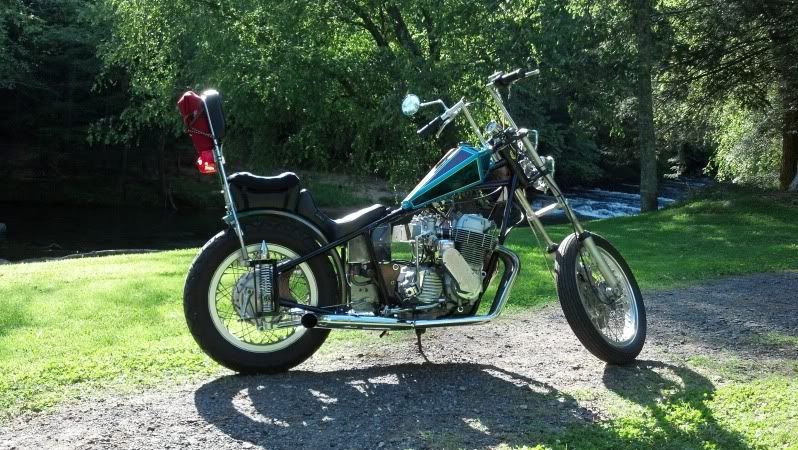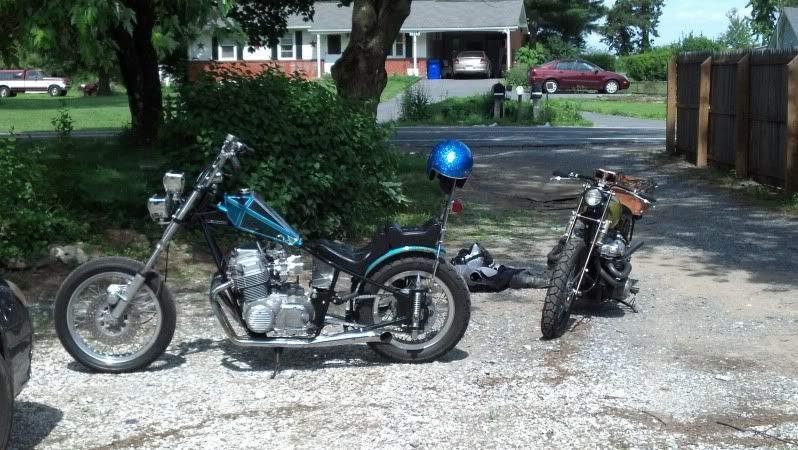Time to wrap up the top end of the Flute. I've already retorqued my head bolts and found true TDC. Next I installed the cam tower pucks. I've added some yamabond so that I can reduce the chance of developing a leak down the road. These little pucks are what cause an old engine to weep oil from between the head fins. Most notable on the left side of the bike since the oil will run across the fins toward the kickstand. I also installed the guide dowels, four small orings and the oil injectors (not shown in the picture below).

I replaced my cam towers, rocker shafts, and rockers after noticing some damage. The picture below shows damage to the cam race on one of my cam towers. This probably happened while installing the old cam. When replacing cam towers, remember that the top shell and the main body of the tower that make the cam race are line bored and must be kept as a set. These parts are labeled with two identical letters. An example can be seen a few pictures below (for example, the cam race top shell is labeled FF and the right side of the cam tower is labeled FF, these parts should go together).
I went through quite a few towers to find ones that mic-ed close to the original specs.
Once the parts were cleaned, I installed them on top of the head. Make sure that if you use a little sealant on the cam pucks that you wipe off the excess. Any extra sealant can cause the cam tower to sit a little higher and cause more friction at the cam races. And once you've installed the cam towers, do not lift them back up. You will pull the pucks out of the seat and have to reinstall them. Lay a little oil down on the races and inside the rocker shaft bores. I'm using 30 weight since I have it on hand.
Slide the cam in from the left side, first through the chain and then through sprocket. Be as gentle as possible with the cam and try not to rest it on the cam towers until all the races are lined up.
Next I installed my rockers with the tappets completely loose. With a stock cam, you should be able to slide the cam in through the rockers with the tappets fully recessed into the rockers. The lift on a stock cam is smaller than the travel of the tappets. This is not the case on an aftermarket cam and you will need to do a bit more work to get the rockers installed. I set my tappet clearances on cylinders 1 and 4 to .005".
Next I lined up the hash marks on the cam with the mating surface of the cam race. The keyway faces up. At this point, cylinder 1 should be in the overlap position between intake and exhaust. This is a decent starting point for degreeing your cam. Note the letters stamped on the end of the rocker tower assembly in the picture below. These two pieces are best friends for life.
With everything bolted in place, apply oil to the small ports on top of the cam tower races, as well as the rocker oiling ports. Give some oil on the lobes and all other areas where there is metal to metal contact.
I verified my lobe centers using the degree wheel and a dial indicator referencing the surface of the valve retainer. I should see 105* int and 104.5* exh. Below is my reading for the exhaust valve of cylinder 1.
Next I measured the lobe center of the intake valve on cylinder 1.
My final readings of the lobe centers are 105* int and 105* exhaust. I'm pleased with those results. degreeing in your cam like this helps to eliminate the propagation of errors in machining tolerances. It allows you to set up the cam as close to the manufacturers specifications by compensating for the modifications and characteristics of your engine. Below is my intake reading.
With all of the tedious stuff out of the way, I installed the cam sprocket bolts, applied the cam chain tensioner, verified tension on the front side of the cam chain, and snugged the sprocket bolts down. Torque to spec and use a little locktite. It can't hurt to be thorough.
Finally, I set all my tappets at .005" clearance, installed the valve cover, and snugged the cam tower support bolts down.
She's almost complete. Carbs, exhaust, plugs, oil, gas, and shes ready to fire.



















































